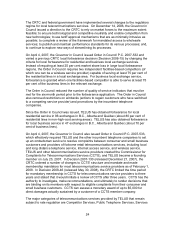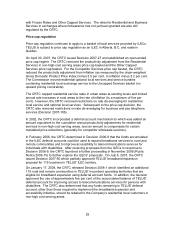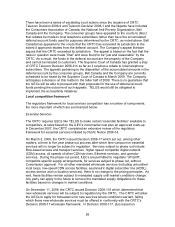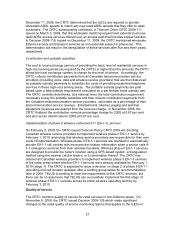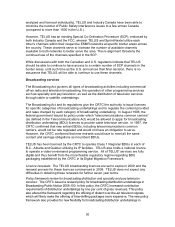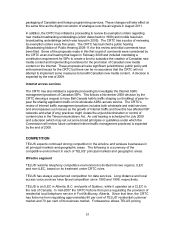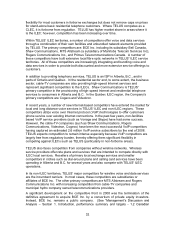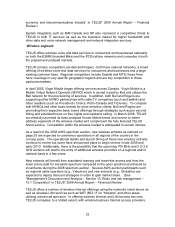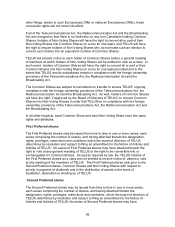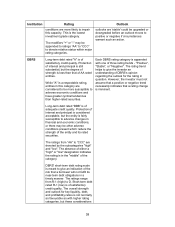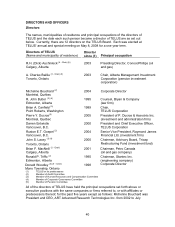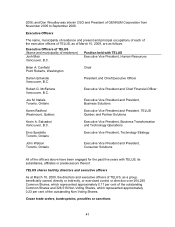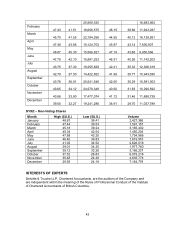Telus 2008 Annual Report Download - page 33
Download and view the complete annual report
Please find page 33 of the 2008 Telus annual report below. You can navigate through the pages in the report by either clicking on the pages listed below, or by using the keyword search tool below to find specific information within the annual report.economy and telecommunications industry” in TELUS’ 2008 Annual Report – Financial
Review.)
System integrators such as IBM Canada and HP also represent a competitive threat to
TELUS in both IT services as well as the business market for higher bandwidth and
other data and voice network management and network integration services.
Wireless segment
TELUS offers wireless voice and data services to consumers and businesses nationally
on both the ESMR (branded Mike) and the PCS/cellular networks and competes in both
the prepaid and postpaid markets.
TELUS’ primary competitors are Bell and Rogers - both have national networks, a broad
offering of wireless voice and data services for consumers and businesses and a large
existing customer base. Regional competitors include Sasktel and MTS; these firms
have coverage in very specific geographic regions and are key competitors in those
particular markets.
In April 2005, Virgin Mobile began offering services across Canada. Virgin Mobile is a
Mobile Virtual Network Operator (MVNO) which is owned in part by Bell and utilizes the
Bell network for the provisioning of services. In addition, both Bell and Rogers are
supporting other MVNO partnerships with cable-TV companies (such as Eastlink) and
other resellers (such as President’s Choice, Petro-Canada and 7-Eleven). To compete
with MVNOs and other basic brands for price-sensitive clients, Bell and Rogers are
promoting their respective basic brand offerings through strategies such as per second
billing and extended hours on free nights and weekend calling. In March 2008, TELUS
successfully launched its basic postpaid Koodo Mobile brand and service to better
address segments of the wireless market and complement the fully featured TELUS
brand service. Competition within the wireless market is anticipated to remain intense.
As a result of the 2008 AWS spectrum auction, new wireless entrants as outlined on
page 29 are expected to commence operations in all regions of the country in the
coming years. The operational details and launch timing of these new wireless entrants
continue to evolve but some have announced plans to begin service in late 2009 and
early 2010. Additionally, there is the possibility that the upcoming 700 MHz and 2.5/ 2.6
GHz auctions will lead to the entry of additional wireless providers on a regional and/or
national basis in a few years.
New entrants will benefit from mandated roaming and tower/site access and from the
lower prices paid for set-aside spectrum compared to the open spectrum purchased by
incumbents during the 2008 spectrum auction. Several AWS auction participants such
as regional cable operators (e.g., Videotron) and new entrants (e.g., Globalive) are
expected to deploy discount strategies in order to gain market share. (See
“Management’s Discussion and Analysis – Section 10. Risks and risk management –
10.1 Competition” in TELUS’ 2008 Annual Report – Financial Review.
TELUS offers a number of wireless Internet offerings using the networks noted above as
well as wireless LAN services such as WiFi (802.11) in “hotspots” and other areas
utilizing unlicenced spectrum. In offering wireless Internet and LAN access services,
TELUS competes, to a limited extent, with wireline business Internet access providers.
33



